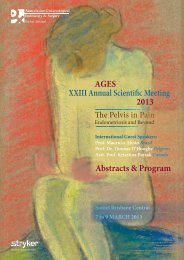to Obstetric Trauma Pelvic Floor Repair Surgical Essentials - AGES
to Obstetric Trauma Pelvic Floor Repair Surgical Essentials - AGES
to Obstetric Trauma Pelvic Floor Repair Surgical Essentials - AGES
Create successful ePaper yourself
Turn your PDF publications into a flip-book with our unique Google optimized e-Paper software.
<strong>AGES</strong><br />
<strong>Pelvic</strong> <strong>Floor</strong><br />
Symposium &<br />
Workshop XII<br />
2011<br />
<strong>to</strong><br />
<strong>Obstetric</strong> <strong>Trauma</strong><br />
<strong>Pelvic</strong> <strong>Floor</strong> <strong>Repair</strong><br />
<strong>Surgical</strong> <strong>Essentials</strong><br />
24<br />
instruments <strong>to</strong> counter the very pertinent issue of cost. S-PORTAL’s<br />
multichannel access ports come by the names of CUSCHIERI<br />
ENDOCONE and X-CONE, each with innovative methods for<br />
insertion. Meanwhile, triangulation of instruments is achieved with<br />
DAPRI instruments, which like the Roticula<strong>to</strong>r by Covidien, has been<br />
developed <strong>to</strong> bend along the shaft of the instrument.<br />
The initial experience and technique of both methods will be<br />
demonstrated in a video presentation. The authors will discuss<br />
the benefits and disadvantages of the SILS versus the S-PORTAL<br />
approach. The presentation will also include a summary of the<br />
various single incision laparoscopic surgery approaches available.<br />
AUTHOR AFFILIATION: S. Lee, S. Soo, C. Ang; Royal Women’s<br />
Hospital, Parkville, Vic<strong>to</strong>ria, Australia.<br />
Session 7 - Free Communications B<br />
1420-1430<br />
Z Plasty vaginal reconstruction<br />
in cases of vaginal constriction: a<br />
video presentation<br />
Singh R, Carey M<br />
Vaginal constriction and associated dyspareunia can be a<br />
complication of vaginal surgery. It can arise after repair of obstetric<br />
injuries, post hysterec<strong>to</strong>my, after vaginal reconstructive procedures<br />
with excessive trimming of vaginal mucosa. These patients require<br />
a careful assessment with pain mapping; identification of trigger<br />
points, perineal or vaginal scarring, reduced vaginal calibre or<br />
mesh complications. Any atrophy, infections and inflammations<br />
should be treated. Underlying conditions like lichen sclerosus,<br />
lichen planus or diabetes should be diagnosed and treated. A<br />
multidisciplinary approach is required. Conservative management<br />
using physiotherapy, sexual counselling as well as vaginal dila<strong>to</strong>rs<br />
may improve the symp<strong>to</strong>ms, but surgery <strong>to</strong> correct the vaginal<br />
constriction may be necessary.<br />
The Z plasty technique for vaginal stricture has been well described<br />
in literature. The classic Z plasty used by plastic surgeons has the<br />
advantages of improving the con<strong>to</strong>ur, releasing scar contracture,<br />
and relieving skin tension. It is especially useful <strong>to</strong> treat a vaginal<br />
constriction ring and increase vaginal diameter.<br />
The Z plasty involves an incision that has central and 2 lateral limb<br />
incisions <strong>to</strong> form a Z. The lengths of the three limbs and the angles<br />
formed between the central and lateral limbs are equal. This<br />
incision creates two triangular tissue flaps that are transposed<br />
which change the length as well as orientation of the scar. The<br />
direction of the ‘Z’ can be vertical or horizontal depending on the<br />
location of the stricture. It is practical in women without excessive<br />
scarring so that healthy tissue can be used for the triangular flaps.<br />
As shown in the video a central limb of the Z incision is made<br />
through the length of the constrictive scar and the lateral limbs are<br />
drawn at the 60 o angle <strong>to</strong> the central limb. This is associated with<br />
a 40% gain in functional length once the flaps are transposed.<br />
The flaps are dissected out <strong>to</strong> the edge <strong>to</strong> mobilize the tissue.<br />
Underlying scar tissue is excised and hemostasis is secured.<br />
The Z arms are sutured with a delayed absorbable fine suture<br />
in a tension free closure. This technique has the advantage of<br />
increasing the dimension of the vagina without creating a midline<br />
scar or compromising the length.<br />
It is vital that vaginal surgeons be acquainted with this procedure <strong>to</strong><br />
treat the complication of a vaginal constriction.<br />
AUTHOR AFFILIATION: R. Singh, M. Carey; Royal Womens Hospital,<br />
Parkville, Vic<strong>to</strong>ria, Australia.<br />
Session 7 - Free Communications B<br />
1430-1440<br />
Laparoscopic Anterior<br />
Sacrocolpopexy with Total<br />
Laparoscopic Hysterec<strong>to</strong>my for<br />
anterior and apical compartment<br />
prolapse<br />
Cario G, Rosen D, Aust T, Chou D and Reyftmann L<br />
In our study ‘Is hysterec<strong>to</strong>my Necessary for Laparoscopic <strong>Pelvic</strong><br />
<strong>Floor</strong> repair A prospective study’ 1 we concluded that this<br />
14.3% incidence of reoperation for cervical elongation meant<br />
that we favour Total laparoscopic Hysterec<strong>to</strong>my for symp<strong>to</strong>matic<br />
uterovaginal prolapse <strong>to</strong>gether with Laparoscopic pelvic floor<br />
repair. We also felt that it allowed us more complete reconstitution<br />
of support <strong>to</strong> the pericervical ring and much better access <strong>to</strong> the<br />
high transverse cys<strong>to</strong>coele. We had found that the anterior fornix<br />
was the major area of recurrence.<br />
More recently the SWEC pelvic floor surgeons have moved <strong>to</strong>ward<br />
the Laparoscopic Mesh Sacrocolpoexy plus TLH for major prolapse<br />
involving 2 or 3 compartments. We have also moved <strong>to</strong>ward using<br />
2 separate mesh straps applied separately <strong>to</strong> the anterior defect<br />
and the posterior defect with more extensive dissection and these

















